sensor TOYOTA MIRAI 2020 Owners Manual (in English)
[x] Cancel search | Manufacturer: TOYOTA, Model Year: 2020, Model line: MIRAI, Model: TOYOTA MIRAI 2020Pages: 56, PDF Size: 3.21 MB
Page 3 of 56
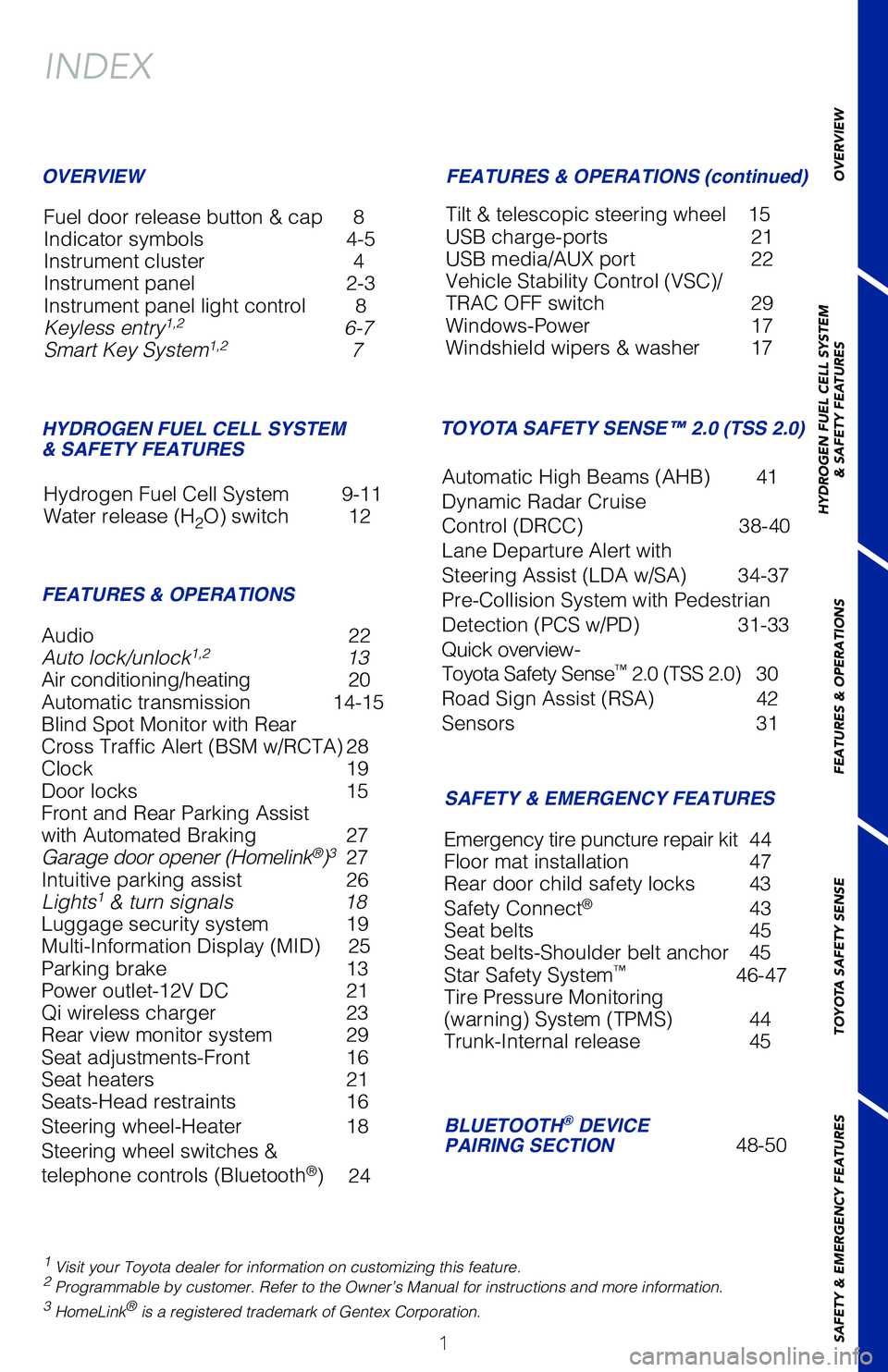
1
OVERVIEW
HYDROGEN FUEL CELL SYSTEM
& SAFETY FEATURES
FEATURES & OPERATIONS
TOYOTA SAFETY SENSE
SAFETY & EMERGENCY FEATURES
Audio 22
Auto lock/unlock1,213
Air conditioning/heating 20
Automatic transmission 14-15
Blind Spot Monitor with Rear
Cross Traffic Alert (BSM w/RCTA) 28
Clock 19
Door locks 15
Front and Rear Parking Assist
with Automated Braking 27
Garage door opener (Homelink
®)3 27
Intuitive parking assist 26
Lights
1 & turn signals 18
Luggage security system 19
Multi-Information Display (MID) 25
Parking brake 13
Power outlet-12V DC 21
Qi wireless charger 23
Rear view monitor system 29
Seat adjustments-Front 16
Seat heaters 21
Seats-Head restraints 16
Steering wheel-Heater 18
Steering wheel switches &
telephone controls (Bluetooth
®) 24
INDEX
Fuel door release button & cap 8
Indicator symbols 4-5
Instrument cluster 4
Instrument panel 2-3
Instrument panel light control 8
Keyless entry
1,26-7
Smart Key System1,27
Hydrogen Fuel Cell System 9-11
Water release (H
2O) switch 12
1 Visit your Toyota dealer for information on customizing this feature.2 Programmable by customer. Refer to the Owner’s Manual for instructio\
ns and more information.3 HomeLink® is a registered trademark of Gentex Corporation.
OVERVIEW
HYDROGEN FUEL CELL SYSTEM
& SAFETY FEATURES
FEATURES & OPERATIONS FEATURES & OPERATIONS (continued)
SAFETY & EMERGENCY FEATURES
Tilt & telescopic steering wheel 15
USB charge-ports 21
USB media/AUX port 22
Vehicle Stability Control (VSC)/
TRAC OFF switch 29
Windows-Power 17
Windshield wipers & washer 17
Emergency tire puncture repair kit 44
Floor mat installation 47
Rear door child safety locks 43
Safety Connect
®43
Seat belts 45
Seat belts-Shoulder belt anchor 45
Star Safety System
™46-47
Tire Pressure Monitoring
(warning) System (TPMS) 44
Trunk-Internal release 45
TOYOTA SAFETY SENSE™ 2.0 (TSS 2.0)
Automatic High Beams (AHB) 41
Dynamic Radar Cruise
Control (DRCC)38-40
Lane Departure Alert with
Steering Assist (LDA w/SA) 34-37
Pre-Collision System with Pedestrian
Detection (PCS w/PD) 31-33
Quick overview-
Toyota Safety Sense
™ 2.0 (TSS 2.0) 30
Road Sign Assist (RSA) 42
Sensors 31
BLUETOOTH® DEVICE
PAIRING SECTION48-50
Page 10 of 56
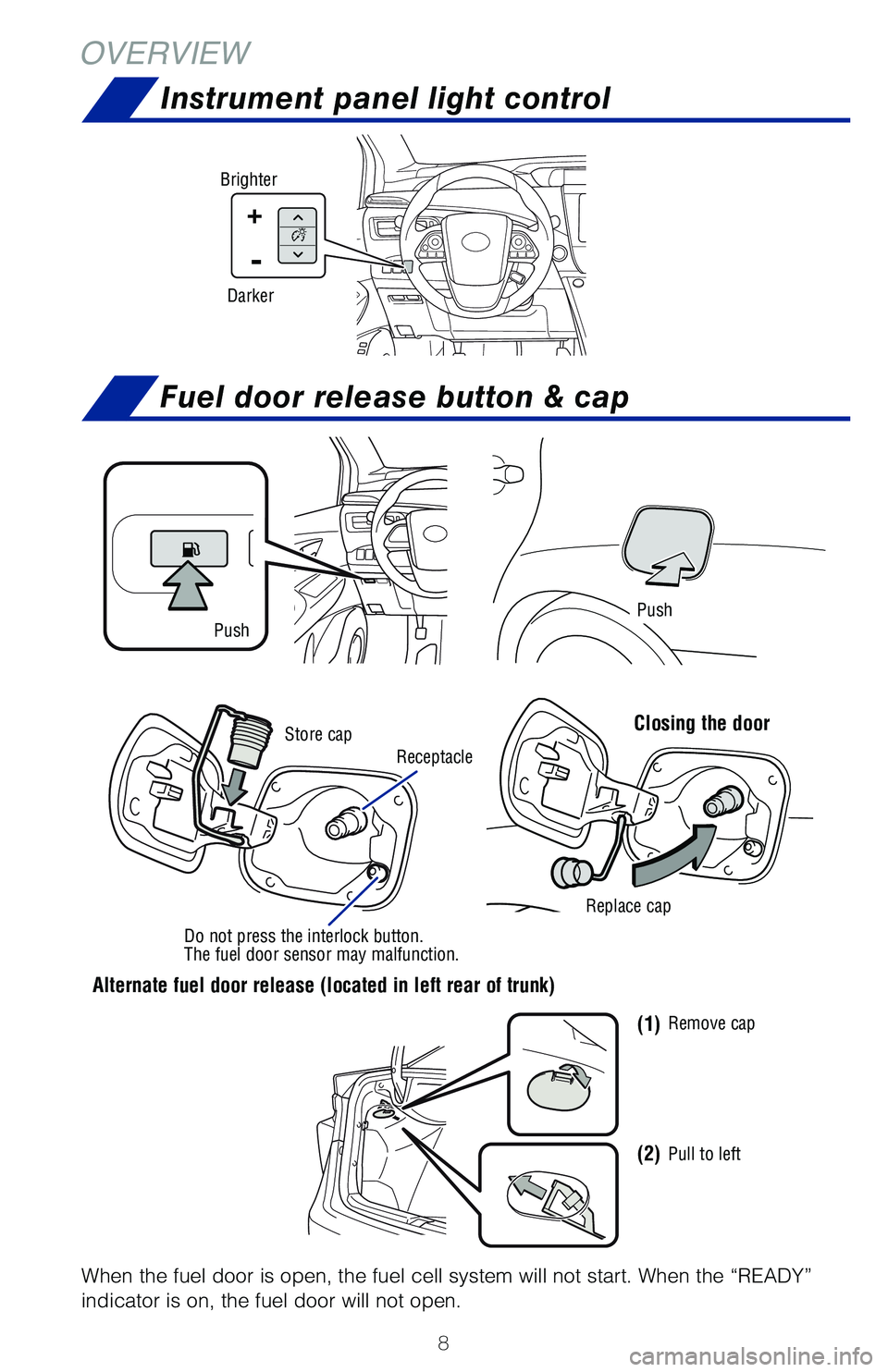
8
OVERVIEW
When the fuel door is open, the fuel cell system will not start. When the “READY”
indicator is on, the fuel door will not open.
PushPush
Store capReplace cap
Do not press the interlock button.
The fuel door sensor may malfunction.
-
+
Darker
Brighter
Alternate fuel door release (located in left rear of trunk)
Remove cap
Pull to left
(1)
(2)
Receptacle
Closing the door
Instrument panel light control
Fuel door release button & cap
Page 19 of 56
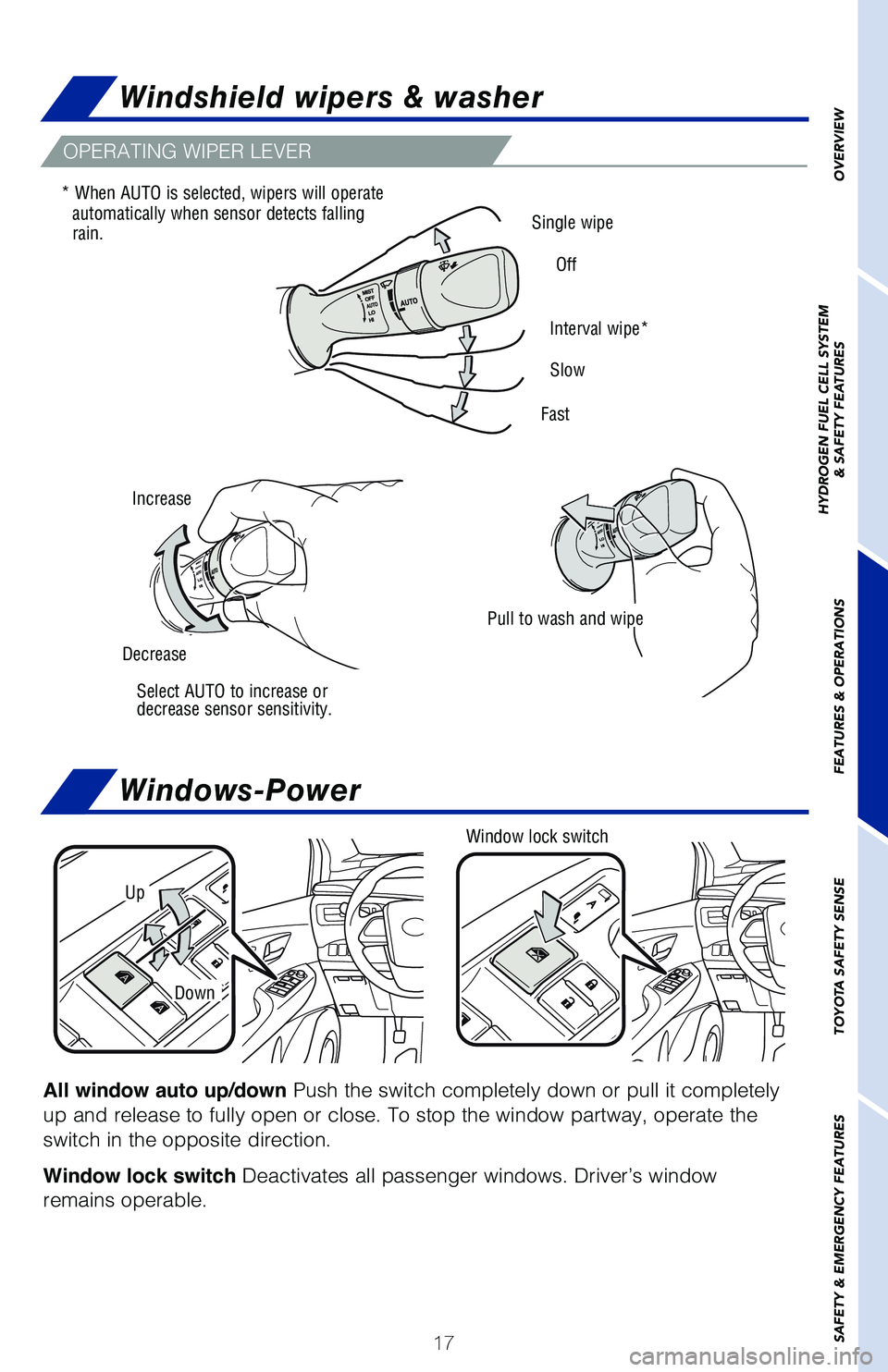
17
OVERVIEW
HYDROGEN FUEL CELL SYSTEM
& SAFETY FEATURES
FEATURES & OPERATIONS
TOYOTA SAFETY SENSE
SAFETY & EMERGENCY FEATURES
OPERATING WIPER LEVER
Pull to wash and wipe
Select AUTO to increase or
decrease sensor sensitivity.
* When AUTO is selected, wipers will operate
automatically when sensor detects falling
rain.
Increase
Decrease
Windows-Power
Up
Window lock switch
All window auto up/down Push the switch completely down or pull it completely
up and release to fully open or close. To stop the window partway, opera\
te the
switch in the opposite direction.
Window lock switch Deactivates all passenger windows. Driver’s window
remains operable.
Down
Single wipe
Interval wipe*
Slow
Fast Off
Windshield wipers & washer
Page 28 of 56

26
FEATURES & OPERATIONSIntuitive parking assist
If the sensors detect an obstacle, the buzzer and MID display informs the driver of
the approximate position and distance of the obstacle by illuminating co\
ntinuously
(far) or blinking (near).
Note: Use
, and of the meter control switches to select
and in the Multi-Information Display (MID) to change settings. The
system will continue in the last state it was in (ON or OFF) when the ignition is
turned on again.
Refer to the Owner’s Manual for limitations and more details.
Front
center sensor
Rear
center sensor
Corner sensors
(front)
Corner sensors
(front)
Corner sensors
(rear) Corner sensors
(rear)
Page 29 of 56

27
Garage door opener (Homelink®)*
Garage door openers manufactured under license from HomeLink®* can be
programmed to operate garage doors, estate gates, security lighting, etc\
.
Refer to “Garage door opener,” Section 6-4 in the Owner’s Manua\
l for more details.
For programming assistance, contact HomeLink
® at 1-800-355-3515, or visit http://
www.homelink.com/toyota.
* HomeLink® is a registered trademark of Gentex Corporation.
Homelink®indicator light
Homelink®icon -
illuminates while operating
Garage door operation indicatorsButtons
Front and Rear Parking Assist with Automated
Braking
(if equipped)
When a collision may occur with an obstacle while parking or traveling a\
t low
speeds, when the vehicle suddenly moves forward due to mistaken accelera\
tor
pedal operation, or when the vehicle moves due to the wrong shift positi\
on being
selected, the sensors are designed to detect obstacles to the front or r\
ear in the
traveling direction of the vehicle, and the system operates to lessen im\
pact with
obstacles such as walls, and reduce resulting damage.
CHANGE SETTINGS
Note: Use, and of the meter control switches to select
and in the Multi-Information Display (MID) to change settings. The system
will continue in the last state it was in (ON or OFF) when the ignition is turned
on again.
Refer to section PKSB (Parking Support Brake function) in the Owner’\
s Manual for
limitations and more details.
OVERVIEW
HYDROGEN FUEL CELL SYSTEM
& SAFETY FEATURES
FEATURES & OPERATIONS
TOYOTA SAFETY SENSE
SAFETY & EMERGENCY FEATURES
Page 30 of 56

28
FEATURES & OPERATIONSBlind Spot Monitor with Rear Cross Traffic
Alert (BSM w/RCTA)
The Blind Spot Monitor is a system that has two functions:
• The Blind Spot Monitor function (assists the driver in making the decision when to
change lanes)
• The Rear Cross Traffic Alert function (assists the driver when backing up)
The system is designed to use radar sensors to detect vehicles traveling\
in the
Mirai’s blind spot. If a vehicle is detected, the driver will be aler\
ted via the outside
rear view side mirror indicators.
Rear Cross Traffic Alert function:
While in reverse, when a vehicle approaching from the right or left rear\
of the Mirai
is detected, the outside rear view mirror indicators flash.
Refer to the Owner‘s Manual for limitation and more details on this s\
ystem before
attempting to use it.
Use
, and of the meter control switches to select and
in the Multi-Information Display (MID) to change settings.
Outside rear view mirror indicators
Buzzer (RCTA only)
TURN THE BSM SYSTEM ON
Page 32 of 56
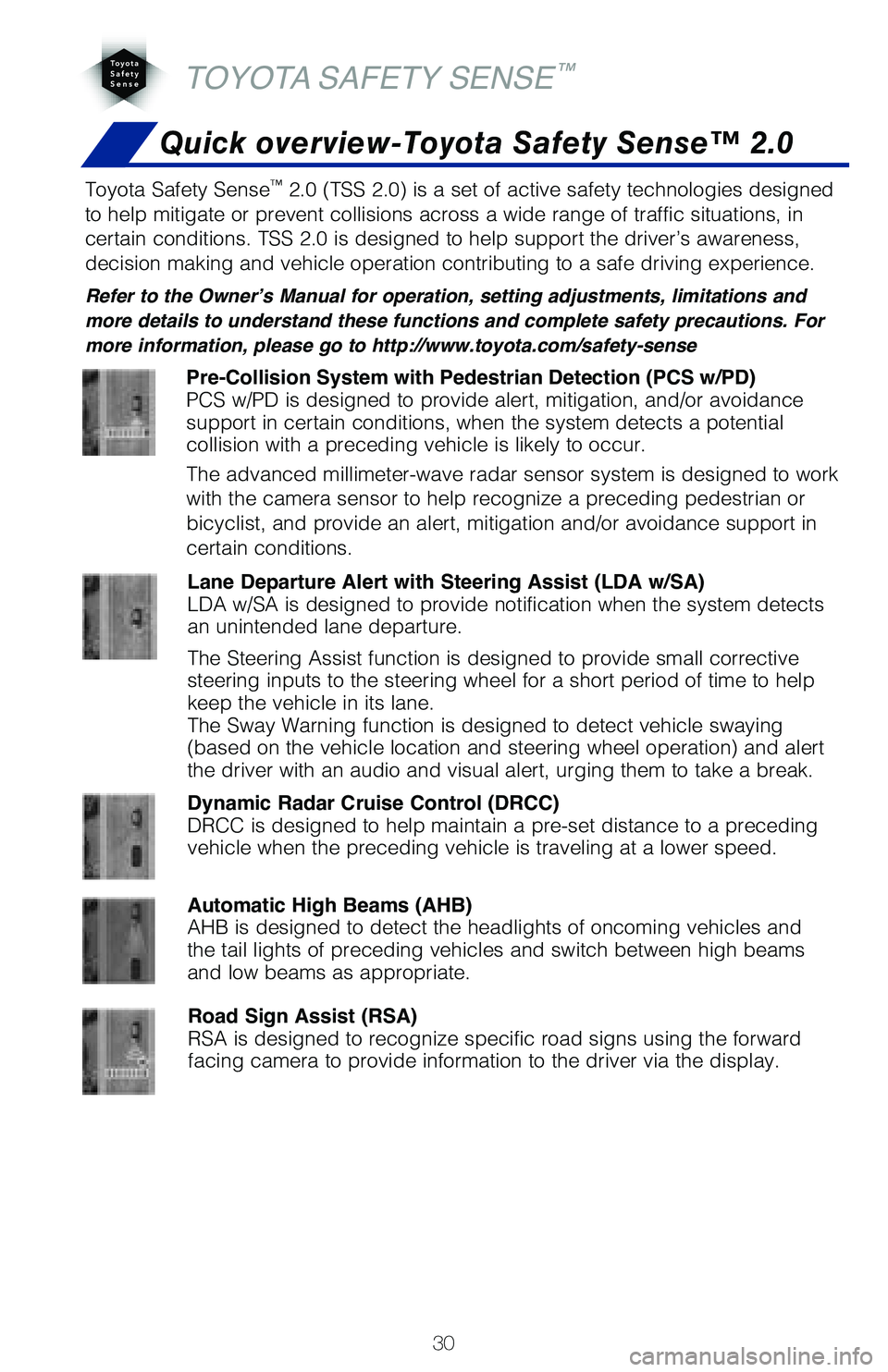
30
TOYOTA SAFETY SENSE™
Toyota Safety Sense™ 2.0 (TSS 2.0) is a set of active safety technologies designed
to help mitigate or prevent collisions across a wide range of traffic si\
tuations, in
certain conditions. TSS 2.0 is designed to help support the driver’s \
awareness,
decision making and vehicle operation contributing to a safe driving exp\
erience.
Refer to the Owner’s Manual for operation, setting adjustments, limitations and
more details to understand these functions and complete safety precautions. For
more information, please go to http://www.toyota.com/safety-sense
Quick overview-Toyota Safety Sense™ 2.0
Lane Departure Alert with Steering Assist (LDA w/SA)
LDA w/SA is designed to provide notification when the system detects
an unintended lane departure.
The Steering Assist function is designed to provide small corrective
steering inputs to the steering wheel for a short period of time to help\
keep the vehicle in its lane.
The Sway Warning function is designed to detect vehicle swaying
(based on the vehicle location and steering wheel operation) and alert
the driver with an audio and visual alert, urging them to take a break.
Automatic High Beams (AHB)
AHB is designed to detect the headlights of oncoming vehicles and
the tail lights of preceding vehicles and switch between high beams
and low beams as appropriate.
Road Sign Assist (RSA)
RSA is designed to recognize specific road signs using the forward
facing camera to provide information to the driver via the display.
Pre-Collision System with Pedestrian Detection (PCS w/PD)
PCS w/PD is designed to provide alert, mitigation, and/or avoidance
support in certain conditions, when the system detects a potential
collision with a preceding vehicle is likely to occur.
The advanced millimeter-wave radar sensor system is designed to work
with the camera sensor to help recognize a preceding pedestrian or
bicyclist, and provide an alert, mitigation and/or avoidance support in \
certain conditions.
Dynamic Radar Cruise Control (DRCC)
DRCC is designed to help maintain a pre-set distance to a preceding
vehicle when the preceding vehicle is traveling at a lower speed.
Page 33 of 56
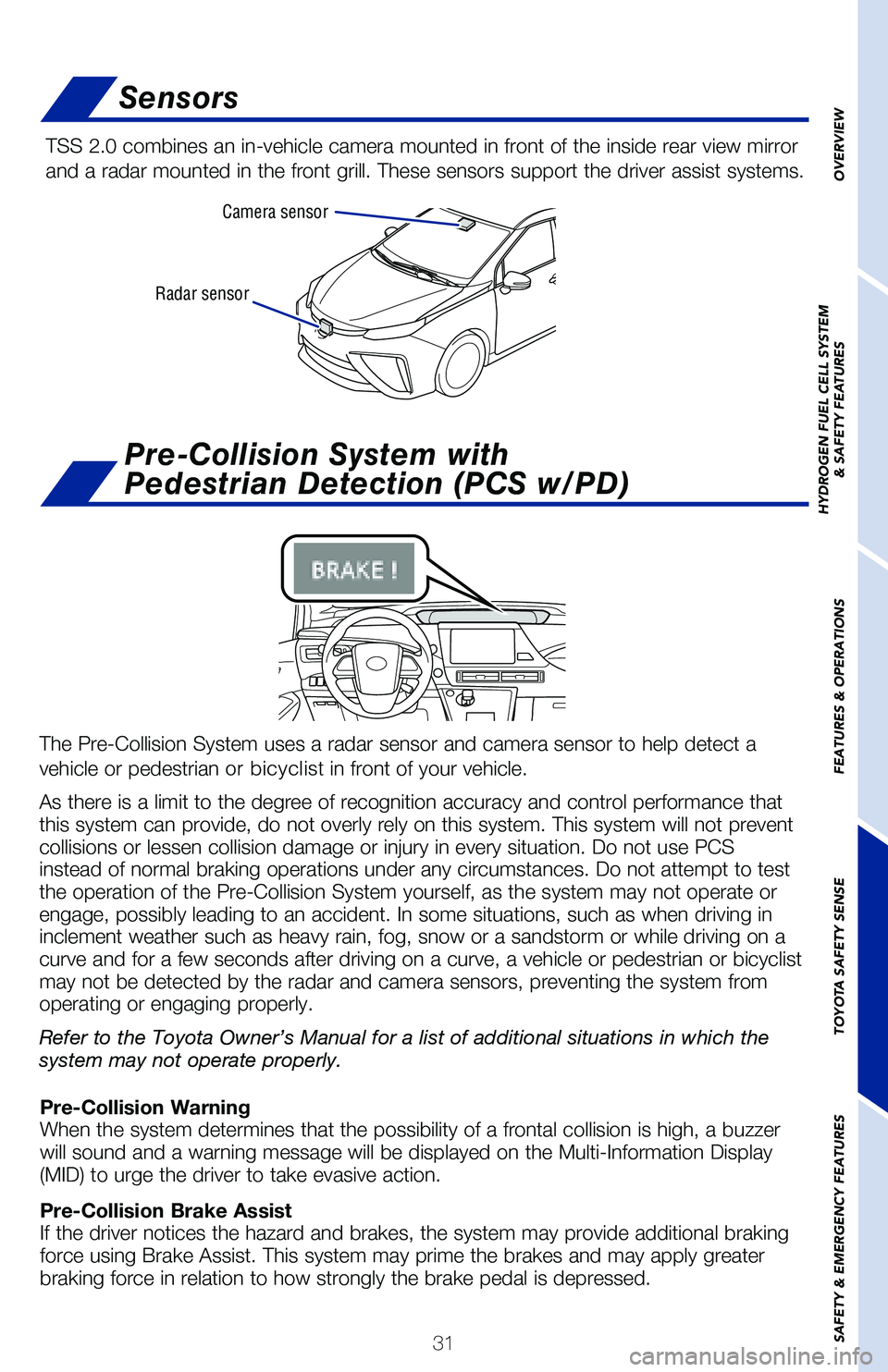
31
Radar sensorCamera sensor
Sensors
TSS 2.0 combines an in-vehicle camera mounted in front of the inside rea\
r view mirror
and a radar mounted in the front grill. These sensors support the driver\
assist systems.
The Pre-Collision System uses a radar sensor and camera sensor to help d\
etect a
vehicle or pedestrian or bicyclist in front of your vehicle.
As there is a limit to the degree of recognition accuracy and control pe\
rformance that
this system can provide, do not overly rely on this system. This system \
will not prevent
collisions or lessen collision damage or injury in every situation. Do n\
ot use PCS
instead of normal braking operations under any circumstances. Do not att\
empt to test
the operation of the Pre-Collision System yourself, as the system may no\
t operate or
engage, possibly leading to an accident. In some situations, such as whe\
n driving in
inclement weather such as heavy rain, fog, snow or a sandstorm or while \
driving on a
curve and for a few seconds after driving on a curve, a vehicle or pedes\
trian or bicyclist
may not be detected by the radar and camera sensors, preventing the syst\
em from
operating or engaging properly.
Refer to the Toyota Owner’s Manual for a list of additional situation\
s in which the
system may not operate properly.
Pre-Collision Warning
When the system determines that the possibility of a frontal collision i\
s high, a buzzer
will sound and a warning message will be displayed on the Multi-Informat\
ion Display
(MID) to urge the driver to take evasive action.
Pre-Collision Brake Assist
If the driver notices the hazard and brakes, the system may provide addi\
tional braking
force using Brake Assist. This system may prime the brakes and may apply\
greater
braking force in relation to how strongly the brake pedal is depressed.
Pre-Collision System with
Pedestrian Detection (PCS w/PD)
OVERVIEW
HYDROGEN FUEL CELL SYSTEM
& SAFETY FEATURES
FEATURES & OPERATIONS
TOYOTA SAFETY SENSE
SAFETY & EMERGENCY FEATURES
Page 34 of 56
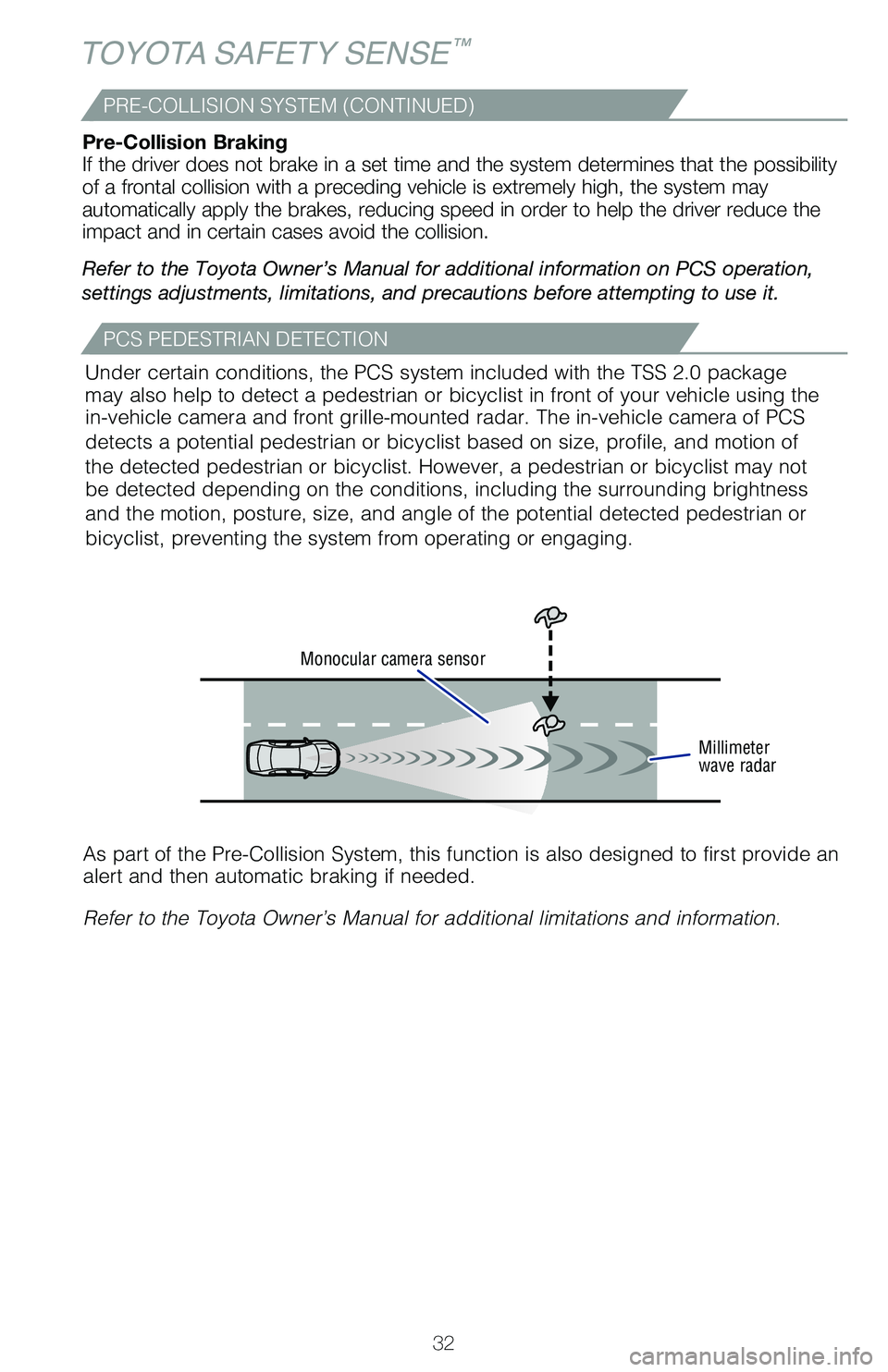
32
PRE-COLLISION SYSTEM (CONTINUED)
TOYOTA SAFETY SENSE™
Refer to the Toyota Owner’s Manual for additional information on PCS \
operation,
settings adjustments, limitations, and precautions before attempting to \
use it. Pre-Collision Braking
If the driver does not brake in a set time and the system determines tha\
t the possibility
of a frontal collision with a preceding vehicle is extremely high, the s\
ystem may
automatically apply the brakes, reducing speed in order to help the driv\
er reduce the
impact and in certain cases avoid the collision.
Monocular camera sensorMillimeter
wave radar
As part of the Pre-Collision System, this function is also designed to f\
irst provide an
alert and then automatic braking if needed.
Refer to the Toyota Owner’s Manual for additional limitations and inf\
ormation.Under certain conditions, the PCS system included with the TSS 2.0 packa\
ge
may also help to detect a pedestrian or bicyclist in front of your vehic\
le using the
in-vehicle camera and front grille-mounted radar. The in-vehicle camera \
of PCS
detects a potential pedestrian or bicyclist based on size, profile, and motion of
the detected pedestrian or bicyclist. However, a pedestrian or bicyclist\
may not
be detected depending on the conditions, including the surrounding brigh\
tness
and the motion, posture, size, and angle of the potential detected pedestrian
or
bicyclist, preventing the system from operating or engaging.
PCS PEDESTRIAN DETECTION
Page 41 of 56
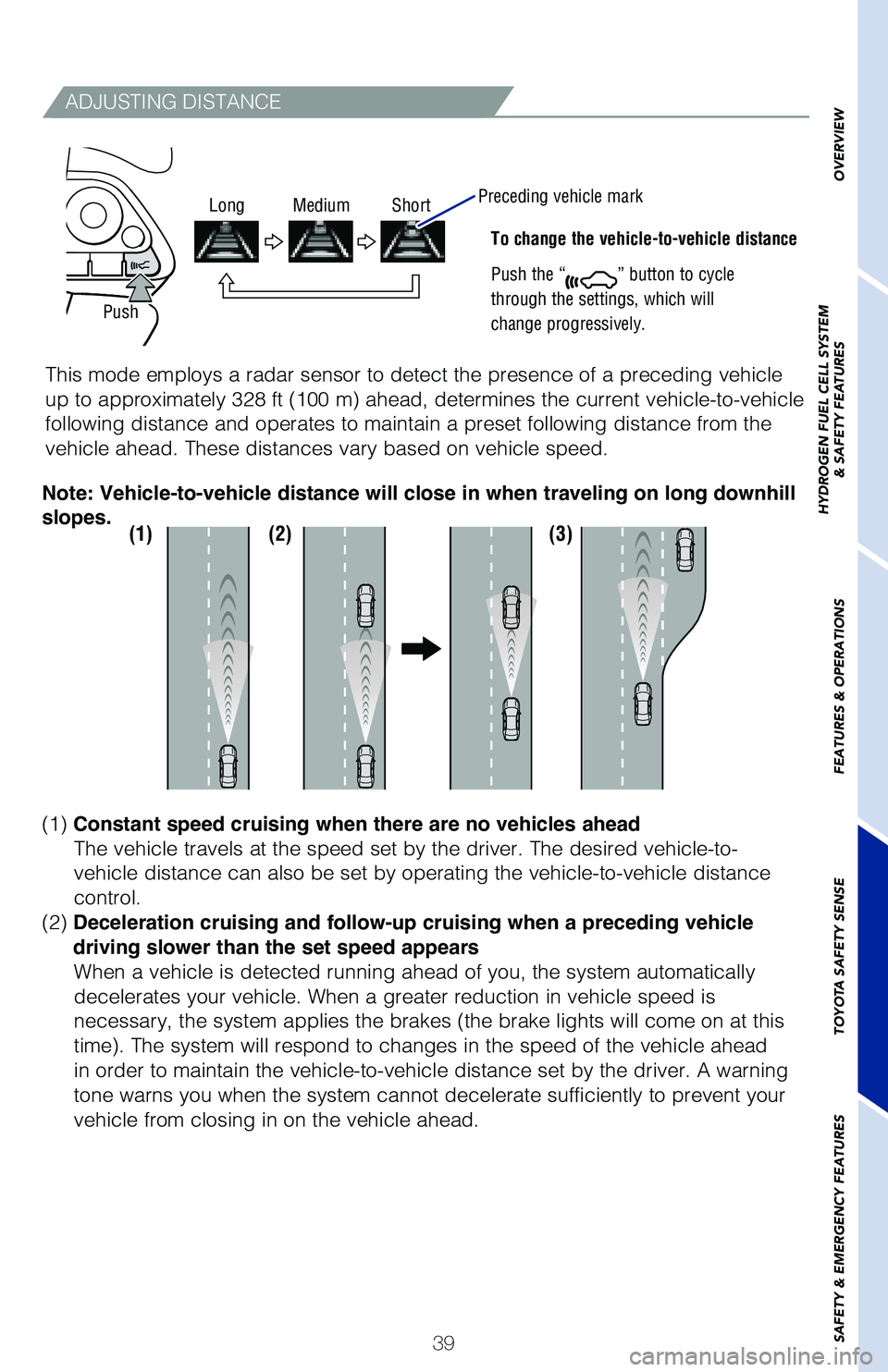
39
ADJUSTING DISTANCE
To change the vehicle-to-vehicle distance
Push the “
” button to cycle
through the settings, which will
change progressively.
This mode employs a radar sensor to detect the presence of a preceding v\
ehicle
up to approximately 328 ft (100 m) ahead, determines the current vehicle-to-vehicle
following distance and operates to maintain a preset following distance \
from the
vehicle ahead. These distances vary based on vehicle speed.
(1)(2)(3)
(1) Constant speed cruising when there are no vehicles ahead
The vehicle travels at the speed set by the driver. The desired vehicle-\
to-
vehicle distance can also be set by operating the vehicle-to-vehicle dis\
tance
control.
(2) Deceleration cruising and follow-up cruising when a preceding vehicle
driving slower than the set speed appears When a vehicle is detected running ahead of you, the system automaticall\
y
decelerates your vehicle. When a greater reduction in vehicle speed is
necessary, the system applies the brakes (the brake lights will come on at this
time). The system will respond to changes in the speed of the vehicle ahead
in order to maintain the vehicle-to-vehicle distance set by the driver. \
A warning
tone warns you when the system cannot decelerate sufficiently to prevent\
your
vehicle from closing in on the vehicle ahead.
Note: Vehicle-to-vehicle distance will close in when traveling on long downhill
slopes.
Push
Long Medium Short
Preceding vehicle mark
OVERVIEW
HYDROGEN FUEL CELL SYSTEM
& SAFETY FEATURES
FEATURES & OPERATIONS
TOYOTA SAFETY SENSE
SAFETY & EMERGENCY FEATURES